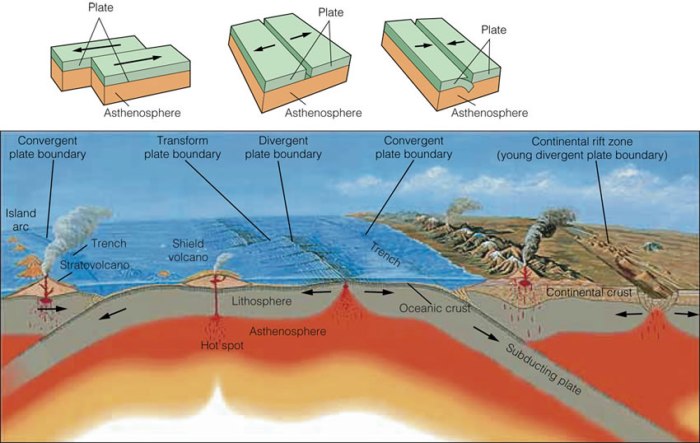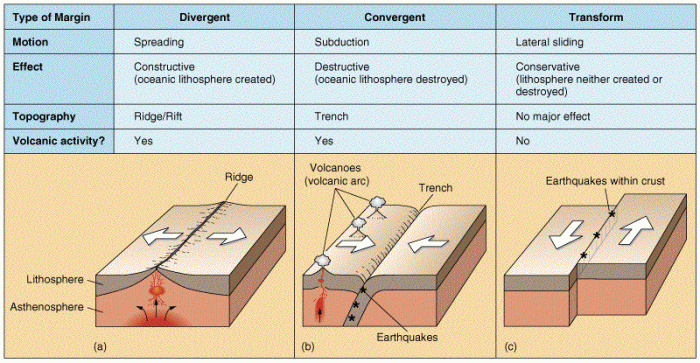Embark on a scientific journey with unit 4 plate tectonics and earth’s interior lab answers, where we unravel the enigmatic forces that shape our planet. This comprehensive guide delves into the intricate interplay between plate tectonics and Earth’s interior, providing a profound understanding of the processes that have sculpted our world.
Through a captivating exploration of plate boundaries, Earth’s layered structure, and the interplay between surface features and internal dynamics, this resource unveils the secrets of our planet’s past, present, and future.
Plate Tectonics and Earth’s Interior

Plate tectonics is the theory that Earth’s lithosphere is divided into several rigid plates that move relative to each other. These plates are composed of the crust and uppermost mantle, and they float on the asthenosphere, a layer of partially molten rock.
Plate tectonics is driven by convection currents in the Earth’s mantle. As hot material rises from the core, it cools and sinks back down, creating a circular pattern of movement. This movement causes the plates to move, and it is responsible for the formation of mountains, volcanoes, and earthquakes.
Types of Plate Boundaries
There are three main types of plate boundaries:
- Convergent boundaries: When two plates collide, one plate is usually forced to move beneath the other in a process called subduction. This can cause the formation of volcanoes and mountain ranges.
- Divergent boundaries: When two plates move away from each other, new crust is formed in the gap between them. This can create rift valleys and mid-ocean ridges.
- Transform boundaries: When two plates slide past each other, they can create earthquakes and faults.
Examples of Plate Tectonic Features
Some examples of plate tectonic features include:
- The San Andreas Fault in California is a transform boundary.
- The Himalayas are a convergent boundary.
- The Mid-Atlantic Ridge is a divergent boundary.
Earth’s Interior: Unit 4 Plate Tectonics And Earth’s Interior Lab Answers

Earth’s interior is divided into several layers:
- The crust is the outermost layer of Earth, and it is composed of solid rock.
- The mantle is the layer beneath the crust, and it is composed of solid rock that is hotter and denser than the crust.
- The outer core is the layer beneath the mantle, and it is composed of liquid iron and nickel.
- The inner core is the innermost layer of Earth, and it is composed of solid iron and nickel.
Earth’s interior is heated by the decay of radioactive elements and by the gravitational compression of the Earth’s mass. This heat causes the convection currents in the mantle that drive plate tectonics.
Earth’s interior also generates a magnetic field. This magnetic field is caused by the movement of liquid iron in the outer core. The magnetic field protects Earth from harmful solar radiation.
Evidence for the Layered Structure of Earth
There is a lot of evidence to support the layered structure of Earth, including:
- Seismic waves: Seismic waves are waves that travel through the Earth’s interior. The speed of seismic waves changes as they pass through different layers of the Earth, and this can be used to determine the density and composition of each layer.
- Gravity: The Earth’s gravity is stronger at the poles than at the equator. This is because the Earth is not a perfect sphere, but is slightly flattened at the poles. The flattening of the Earth is caused by the centrifugal force of the Earth’s rotation.
- Magnetic field: The Earth’s magnetic field is generated by the movement of liquid iron in the outer core. The strength and direction of the magnetic field can be used to determine the size and shape of the outer core.
Plate Tectonics and Earth’s Surface

Plate tectonics has a major impact on Earth’s surface features. The movement of plates can cause the formation of mountains, volcanoes, and rift valleys. Plate tectonics can also cause earthquakes and tsunamis.
The relationship between plate tectonics and earthquakes is well-known. Earthquakes occur when two plates move past each other, and they can cause significant damage to buildings and infrastructure. The relationship between plate tectonics and volcanoes is also well-known. Volcanoes are formed when magma rises from the Earth’s interior and erupts onto the surface.
Plate tectonics can also cause the formation of mountain ranges. When two plates collide, one plate is usually forced to move beneath the other, and this can cause the formation of mountains.
Plate tectonics has also played a major role in Earth’s history. The movement of plates has caused the continents to move around the globe, and it has also caused the formation of new oceans and the destruction of old ones.
Plate tectonics has also played a role in the evolution of life on Earth. The movement of plates has created new habitats for plants and animals, and it has also caused the extinction of many species.
Laboratory Activities

There are a number of laboratory activities that can be used to demonstrate plate tectonics. One common activity is to use a globe to model the movement of plates. Students can use a marker to draw the boundaries of different plates on the globe, and then they can use their hands to move the plates around.
This activity can help students to visualize how plates move and how they interact with each other.
Another common activity is to use a sandbox to model the formation of mountains. Students can use their hands to create different types of mountains, such as fold mountains and fault-block mountains. This activity can help students to understand how mountains are formed and how they are related to plate tectonics.
Laboratory Experiment: Demonstrating Plate Tectonics, Unit 4 plate tectonics and earth’s interior lab answers
Materials:
- A large sandbox
- Sand
- A piece of cardboard
- A ruler
- A protractor
Procedure:
- Fill the sandbox with sand.
- Use the cardboard to create a plate boundary in the sand. The plate boundary can be any type of boundary, such as a convergent boundary, a divergent boundary, or a transform boundary.
- Use the ruler and protractor to measure the angle of the plate boundary.
- Move the plates around the sandbox to simulate the movement of plates. Observe the changes in the sand as the plates move.
Expected Results:
- The movement of the plates will cause the sand to move and deform.
- The type of plate boundary will determine the type of deformation that occurs.
- The angle of the plate boundary will affect the amount of deformation that occurs.
This experiment can be used to demonstrate the basic principles of plate tectonics. It can also be used to teach students about the different types of plate boundaries and the effects of plate movement.
Top FAQs
What is the significance of plate tectonics?
Plate tectonics is pivotal in shaping Earth’s surface features, driving earthquakes, volcanic eruptions, and mountain building, and influencing the distribution of life forms.
How does Earth’s interior generate heat and magnetism?
Earth’s interior generates heat through radioactive decay and the movement of molten rock, while magnetism arises from the flow of liquid iron in the outer core.
What evidence supports the layered structure of Earth?
Seismic waves provide evidence for Earth’s layered structure, as they travel at different speeds through materials of varying density and composition.